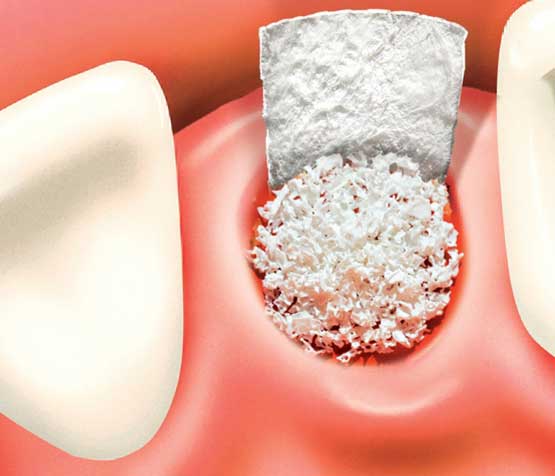Periodontal Disease is the leading cause of bone loss in your mouth. Bone grafting is a procedure used to replace lost bone tissue and to encourage natural bone growth. Bone grafting can be used for a wide variety of periodontal procedures. These days, we have the ability to grow bone where needed.

Types of Bone Grafts
There are several different types of dental bone grafts. These are the most common:
- Autogenous Bone Graft: In this type of graft, the bone is removed from elsewhere in the body and implanted in the mouth. Common donor sites for grafting include the iliac section of the pelvis, the chin and the posterior third molar areas of the jaw. If large amounts of bone need to be harvested, the hip or the shin bone (tibia) are generally used.
- Allograft: Synthetic bone (man-made) can be created in the laboratory and used in the bone grafting procedure. Bone can also be obtained from a bone bank (cadaver bone).
- Xenograft: This is the implantation of bovine (cow) bone. A xenograft is perfectly safe and has been used successfully for many years. Ample bone can be obtained and no secondary donor site is necessary.
Why do you need Bone Grafting?
There are many reasons why you may need a bone graft, but generally, the most common reason is to restore the jaw bone.
What Procedures are Used With Grafting?
We use bone grafts for many periodontal procedures, but we use it most frequently in these procedures:
- Dental Implants: Dental Implants are the preferred replacement method for missing teeth because they restore full functionality to the mouth; however, implants need to be firmly anchored to the jawbone to be effective. If the jawbone lacks the necessary quality or quantity of bone, grafting can strengthen and thicken the implant site.
- Sinus Lift: A sinus lift entails elevating the sinus membrane and grafting bone onto the sinus floor so that implants can be securely placed.
- Ridge Augmentation: Ridges in the bone can occur due to trauma, injury, birth defects or severe periodontal disease. The bone graft is used to fill in the ridge and make the jawbone a uniform shape.
What Does Bone Grafting Treatment Involve?
Bone grafts are generally performed under local anesthetic. However, if a large amount of bone needs to be grafted, general anesthetic may be required to perform the procedure.
The grafting material needs to be either harvested or prepared for insertion. A small incision is made in the gum tissue and then is gently separated from the bone. The bone grafting material is then applied to the affected site.
The gum is then sutured into place and you will be booked for a follow-up appointment to double check the healing process.
To learn more about Bone Grafting, we invite you to contact Peace Periodontics to schedule a consultation appointment.
Featured Periodontal Services
Testimonial
Contact Us
Working Hours
| Monday: | 8:00 am – 5:00 pm |
| Tuesday: | 8:00 am – 5:00 pm |
| Wednesday: | 8:00 am – 5:00 pm |
| Thursday: | 8:00 am – 5:00 pm |
| Friday: | 8:00 am – 2:00 pm |
| Saturday’s, Sunday’s & Statutory Holidays: |
Closed |
